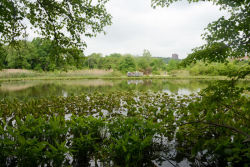Eibs Pond Park
Eibs Pond Park
Eibs Pond Park, located in the Staten Island neighborhood of Park Hill, was named for a German-American family who owned land in the area during the 1800s. They used the pond as a watering hole for their horses and dairy cows. Descendants of the Eibs family continued to live on this site until 1971.
The Eibs Pond area performed varying functions throughout the century. First, the pond enjoyed movie fame, when from 1914 to 1917 several episodes of The Perils of Pauline starring Pearl White and Milton Berle, were filmed in this area. In 1914, D.W. Griffith directed the film Birth of a Nation, shooting his Civil War battles sequences around the pond. From 1915 until 1935, Eibs Pond served as a water hazard for the Fox Hill Golf Links. During the winter, club members would participate in curling competitions on the frozen pond. In the 20s, a military hospital was constructed nearby. From 1944 to 1945, this site served as an army base. Italian prisoners of war were kept here and offered courses in English, hygiene, and military discipline.
The site sat nearly vacant for almost 40 years until the Urban Investment Development Company planned the construction of an apartment building and multi-story hotel overlooking the pond. Amid concerns over the environmental impact of building on this ecologically delicate site, the company chose to donate the land to the Trust for Public Land (TPL). The TPL initially set aside the upper six acres of the site for low-income housing, while the lower eight acres remained in their natural state.
In 1987, the New York State Department of Environmental Conservation designated Eibs Pond and the surrounding area as protected wetlands. Two years later, it became a New York City park. With the help of local volunteer groups, Parks restored the area, removing debris and an artificial barrier that had been erected around the park.
In 1999, the TPL donated an additional 9 acres of land to the park. In the same year, the Fox Hills Tenants Association, led by president Reverend Hattie Smith-Davis, collaborated with the Parks Council to secure $100,000 in funding from foundation grants, and another $100,000 from the Urban Resources Project, a coalition of federal agencies. These funds, along with the efforts of a summer youth employment program, resulted in a major restoration to the park, including soil and water quality improvements, and disabled-access renovations. This completed the 15-year effort to protect the crucial ecological balance of the pond and surrounding wetlands. Despite its relatively small size, Eibs Pond Park serves as habitat for over 80 bird species. The clay-bottomed pond itself covers three acres, making it the largest kettle pond in New York City. Kettle depressions formed from glacial activity occurring 17,000 years ago. Because the only source of water for the pond is rain and runoff, the water level can vary significantly from season to season and year to year. The resulting variety of plant and animal life is quite impressive. Bulrushes (Scirpus), cattails (Typha), cinnamon fern (Osmunda cinnamomea), sassafras (Sassafrass albidum), water lilies (Nymphaea odorata), porcelain berry (Ampelopsis brevipedunculata), common reeds (Phragmites australis), and mugworts (Artemisia vulgaris) all thrive here. Snowy egrets (Egretta thula), bluegill sunfish (Lepomis macrochirus), large-mouth bass (Micropterus dolomieu), painted turtles (Chrysemys picta picta), and muskrats (Ondatra zibethicaFalco peregrinus),.
Located at Mosel Avenue and Palma Drive in the Park Hill neighborhood, Eibs Pond Park sits within one of the most densely populated sections of Staten Island. The Park Hill Houses Complex, and several other nearby apartment buildings contribute 1,850 housing units to the area. As such, local residents appreciate it as a place of refuge amidst the urban landscape. Henry David Thoreau (1817-1862) lived near this site during the summer of 1843. Its beauty led him to comment that “the cedar seems to be one of the most common trees here, and the fields are fragrant with it...The whole island is like a garden.”
Check out your park's Vital Signs
Clean & Safe
Green & Resilient
Empowered & Engaged Users
Share your feedback or learn more about how this park is part of a
Vital Park System



